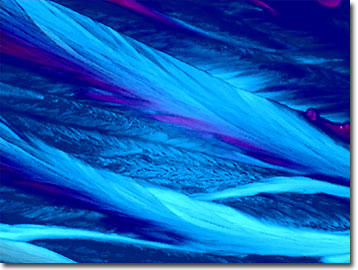Polarized Light Digital Image Gallery
Picric Acid
The first synthetic dye, picric acid, was prepared in 1771 by British chemist Peter Woulfe from the extraction of the natural plant pigment, indigo, treated with nitric acid. Initially used for silk in 1849, picric acid was employed as a yellow dye until 1885 when French organic chemist Jean-Baptiste-André Dumas realized that the yellow crystal was highly explosive.

Sold as wet picric acid or melinite (at least 10 percent water), picric acid has a molecular weight of 229.11 and forms a yellow crystalline solid that is odorless, melts at 122 degrees Celsius and explodes above 300 degrees Celsius (when dry). To chemists, picric acid is also known as 2,4,6-trinitrophenol, carbazotic acid, or picronitric acid and features 6 carbons, 3 hydrogens, 3 nitrogens, and 7 oxygen atoms per molecule arranged in a benzene ring system with covalent bonding. Picric acid takes its name from the Greek picros, which means bitter after its intense bitter taste. Apparently, picric acid is not known to occur in nature, because of its highly unstable and reactive nature.
In 1886, the French began using picric acid as a highly explosive priming charge for shells, and by the Russo-Japanese War (1904-1905), picric acid was the most widely used military explosive, particularly for Japanese torpedoes. Limitations for its use in munitions were realized because of its extreme corrosive abilities on metals, forming metal picrates, which are even more unstable and explosive than picric acid. Even concrete reacts with picric acid, forming calcium picrate. In a chemistry lab, if picric acid dried a metal cap, it became highly unstable and when opening the bottle and creating friction, it would explode. Black powder enthusiasts use picric acid in small quantities in their percussion caps. A more stable form, ammonium picrate, is used by the military for armor piercing rounds that penetrate before detonating. It has also been used as a textile dye, a biological stain, and as a first-aid ointment. Chronic exposure to picric acid may cause damage to the liver and kidneys and it is also an eye, skin, and respiratory irritant.
Contributing Authors
Omar Alvarado, Thomas J. Fellers and Michael W. Davidson - National High Magnetic Field Laboratory, 1800 East Paul Dirac Dr., The Florida State University, Tallahassee, Florida, 32310.
BACK TO THE POLARIZED LIGHT IMAGE GALLERY
BACK TO THE DIGITAL IMAGE GALLERIES
Questions or comments? Send us an email.
© 1995-2025 by Michael W. Davidson and The Florida State University. All Rights Reserved. No images, graphics, software, scripts, or applets may be reproduced or used in any manner without permission from the copyright holders. Use of this website means you agree to all of the Legal Terms and Conditions set forth by the owners.
This website is maintained by our
Graphics & Web Programming Team
in collaboration with Optical Microscopy at the
National High Magnetic Field Laboratory.
Last Modification Friday, Nov 13, 2015 at 01:19 PM
Access Count Since September 17, 2002: 14393
Visit the website of our partner in introductory microscopy education:
|
|
